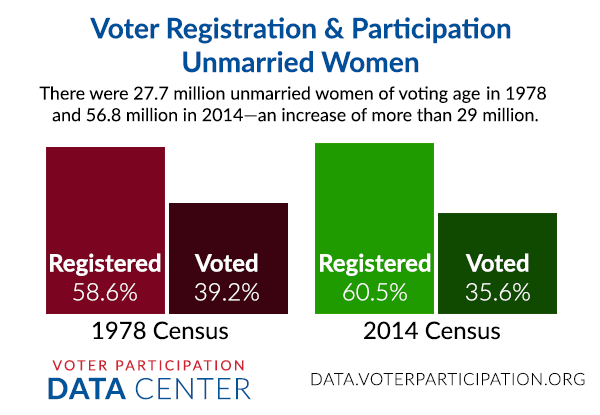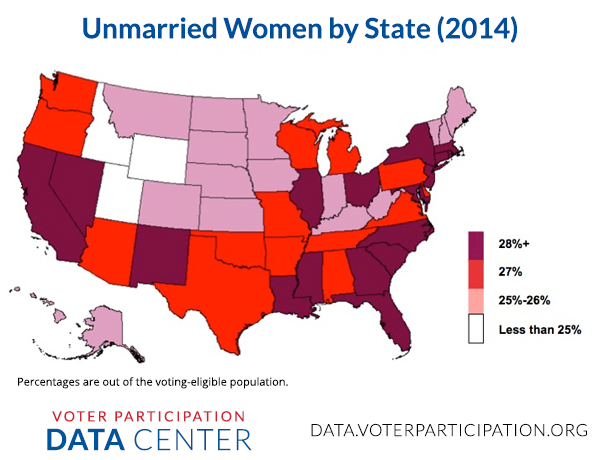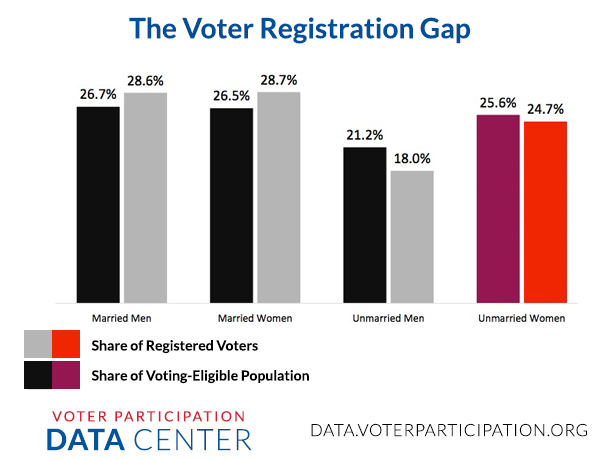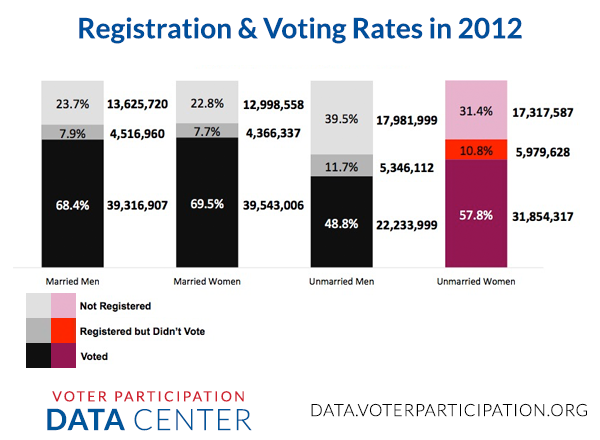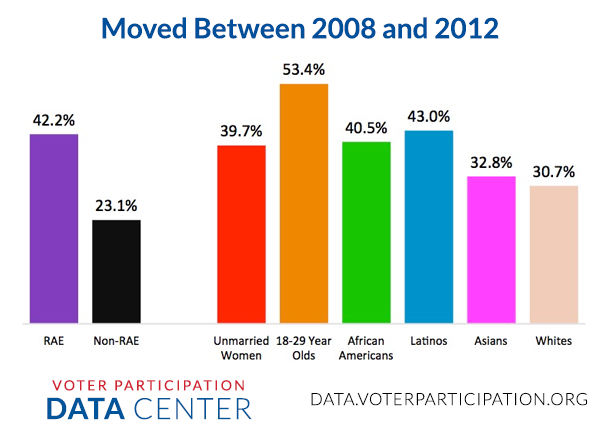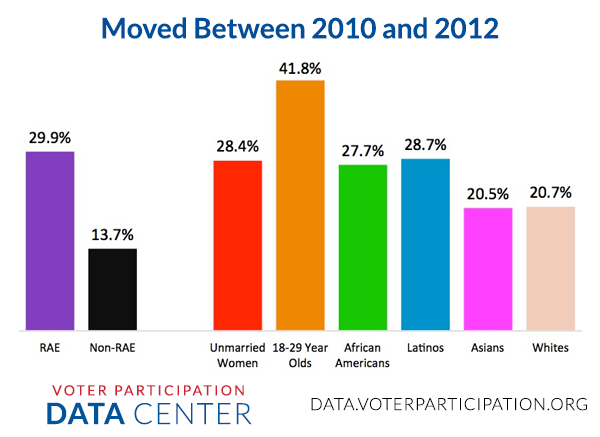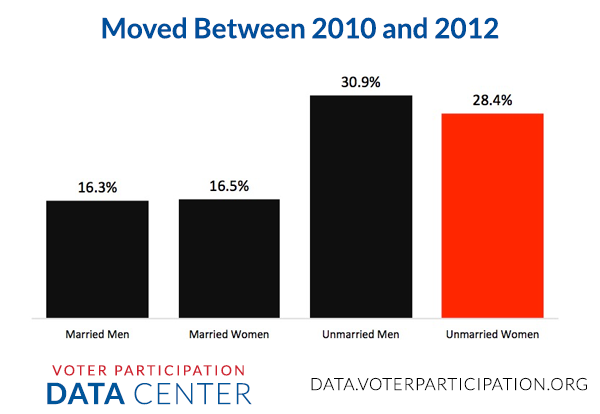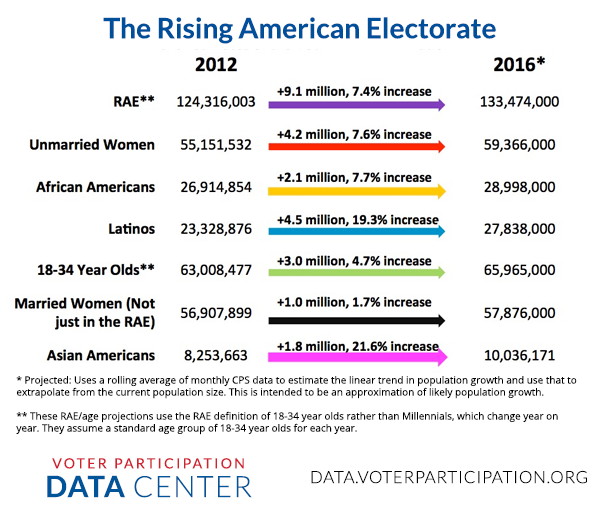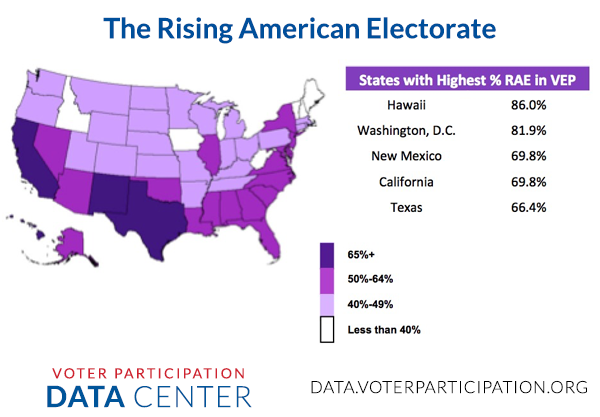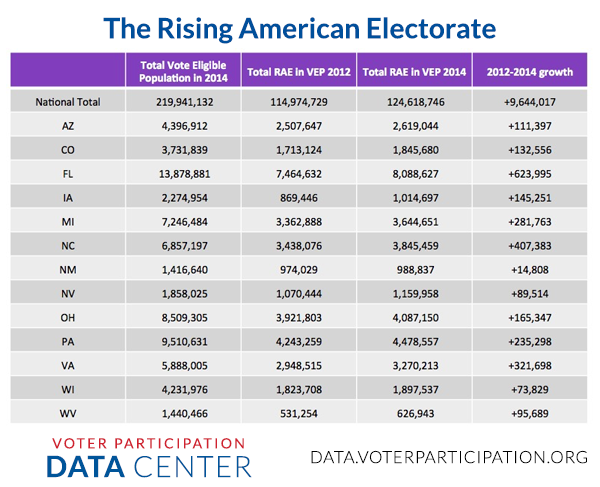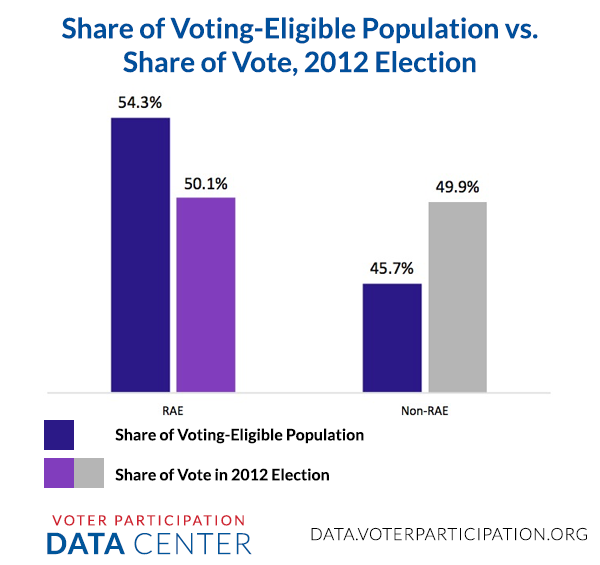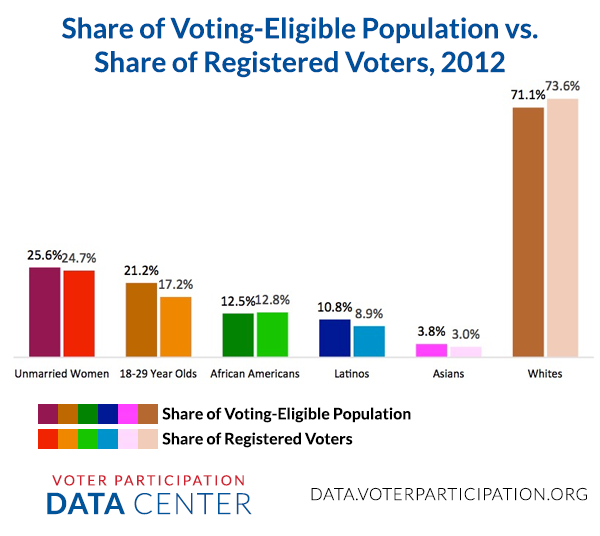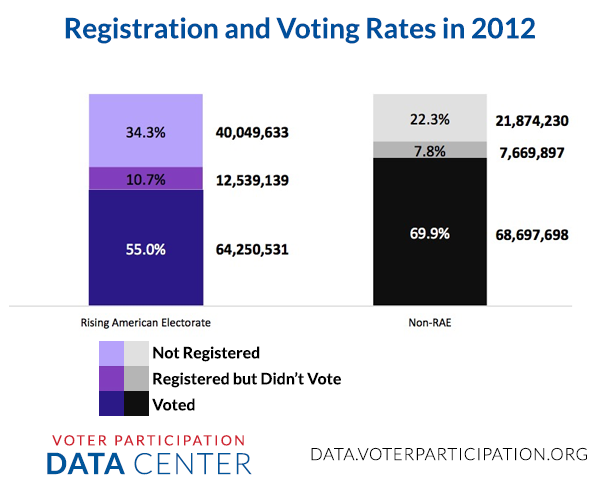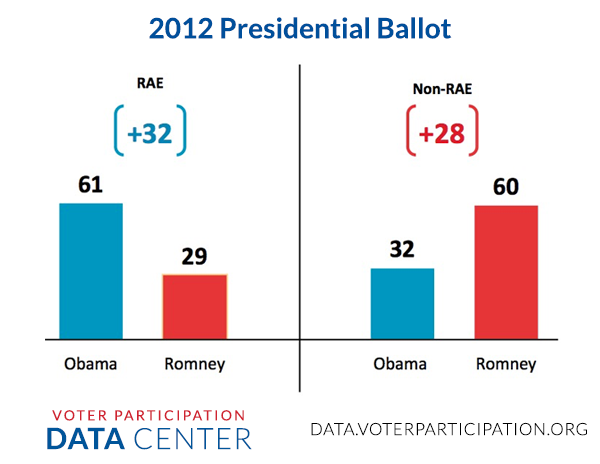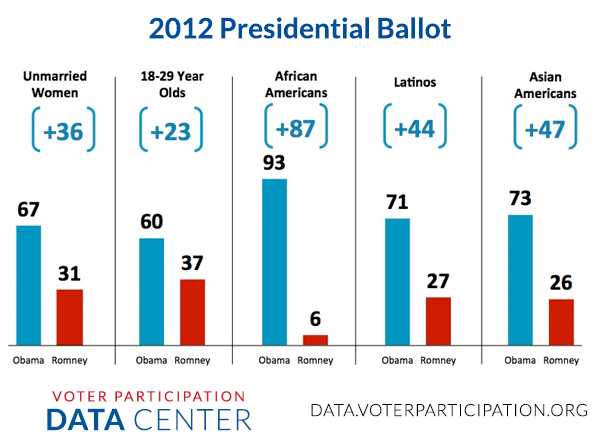New U.S. Census Data and Unmarried Women
The U.S. Census Bureau released its latest information on U.S. Voting patterns.
The new data clearly demonstrates the growing political status of unmarried women from 1978 to last year.
There were 27.7 million unmarried women of voting age in 1978 and 56.8 million in 2014—an increase of more than 29 million. In 2014, the percentage of unmarried women who registered to vote was 60.5%, or about 2 percentage points higher than in 1978, the Census Bureau reported. But the share of single women who voted declined in the non-presidential elections years, from 39.2% in 1978 to 35.6% last year. (In 2012, the last presidential year, the percentage of unmarried women who registered was 68.6% and the voting turnout rate was 57.8%.)
Unmarried Women: An Electoral Profile
Unmarried women, people of color and millennials (age 18-35) now make up the majority (56.7 percent) of the U.S. population. Unmarried women make up one of the largest shares of this Rising American Electorate (RAE).
Almost one of every two women is unmarried. By 2016, for the first time, the majority of women eligible to vote will be unmarried.
Unmarried women are at least 25 percent of the eligible voters in every competitive state.
There is a significant gap between the number of unmarried women who can vote and the number who do vote.
About one in three unmarried women is not eligible to vote.
In 2012, unmarried women and the entire Rising American Electorate overwhelming voted to reelect President Obama.
If only married women had voted in 2012, President Obama would not have been reelected.
An in-depth demographic, economic and political look at unmarried women and the Rising American Electorate from Lake Research Partners.
The Rising American Electorate: A Population on the Move
The Rising American Electorate (RAE) — unmarried women, people of color and young people 18-35 (Millennials) – are highly mobile. Four in ten RAE members moved between the 2008 and 2012 presidential elections and lost their registration status. That makes the re-registration of movers a top priority if the RAE share of the electorate is ever going to match its share of the population of citizens eligible to vote.
Unmarried men and women were more likely to move than married men and women.
Young voters were the most likely to have moved between 2010 and 2012.
More than one in four unmarried women moved between 2010 – 2012.
An in-depth demographic, economic and political look at unmarried women and the Rising American Electorate from Lake Research Partners.
- Unmarried Women: A Demographic and Economic Profile
- Unmarried Women: An Electoral Profile
- The Rising American Electorate: A Profile
- How the Rising American Electorate Register and Vote
- The Rising American Electorate: A Population on the Move
The Rising American Electorate: A Profile
The fast-growing Rising American Electorate (RAE) – unmarried women, people of color and young people 18-35 (Millennials) — now account for more than half (56.7 percent) of all eligible voters in the United States.
All of the groups that make up the RAE are growing rapidly and by 2016, they will likely cast over half of all ballots, making them the majority of the electorate.
The RAE population is growing all across America.
While RAE turnout has increased in recent elections, they still do not vote in proportion to their share of the population.
There is a gap in almost all RAE groups between the number of RAE members who could vote and those who do.
About a third of the RAE is not registered to vote.
Latinos and young people are the least likely to be registered.
RAE turnout in 2012 was 55 percent, compared to an almost 70 percent (69.9 percent) turnout by the rest of the electorate. RAE members who voted in 2012 helped reelect President Obama.
All the groups that make up the RAE overwhelmingly supported President Obama.
An in-depth demographic, economic and political look at unmarried women and the Rising American Electorate from Lake Research Partners.
Unmarried Women: A Demographic and Economic Profile
An in-depth demographic, economic and political look at unmarried women and the Rising American Electorate from Lake Research Partners.
- Unmarried Women: A Demographic and Economic Profile
- Unmarried Women: An Electoral Profile
- The Rising American Electorate: A Profile
- How the Rising American Electorate Register and Vote
- The Rising American Electorate: A Population` on the Move
Unmarried women – women who are widowed, divorced, separated or have never been married – make up one of the fastest-growing shares of the U.S. population and electorate. As their numbers grow so does their power to decide elections, speed social change, and shape the nation’s policy agenda.
Right now, the data shows they are living very different lives than their married counterparts – they earn less, have less education, are more likely to be unemployed, in poverty, without health care coverage or a pension plan.
All data is from 2014, unless otherwise noted and has been pulled from research done by both Lake Research Partners and Bill Johnstone.
Population & Demographics
There are 56.8 million unmarried women in the U.S. They account for 26 percent of the overall population.
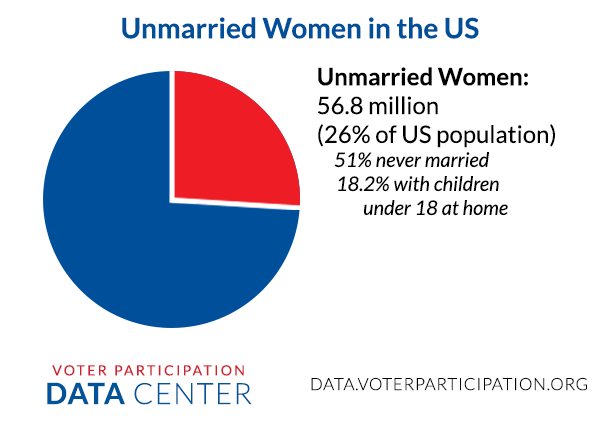
Unmarried women are on a trajectory to equal or surpass the number of married women by the November, 2016 presidential election.

Unmarried women skew young and old:

More than six in ten unmarried women in America are white.
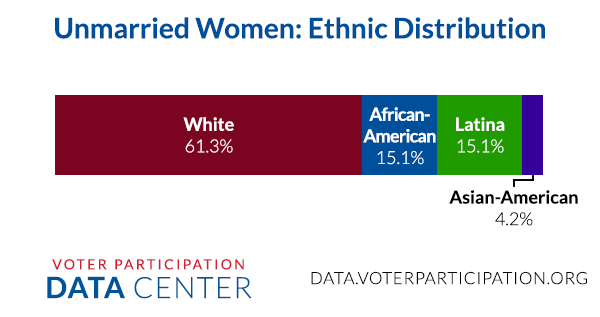
Education & Economics
A significantly higher percentage of married women (37.5 percent) have college and higher degrees than unmarried women (24.1 percent).
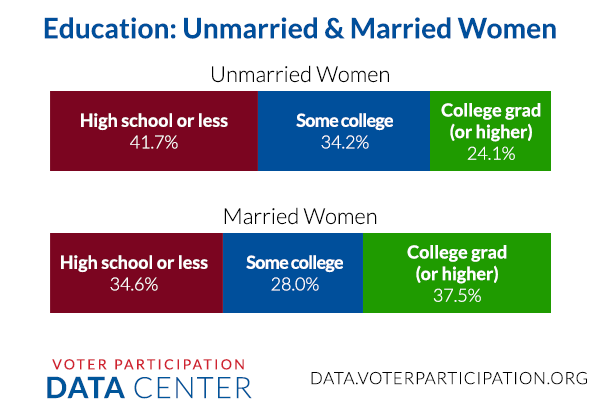
An unmarried woman was more than twice as likely to be unemployed (7.3 percent) as a married woman (3.1%).
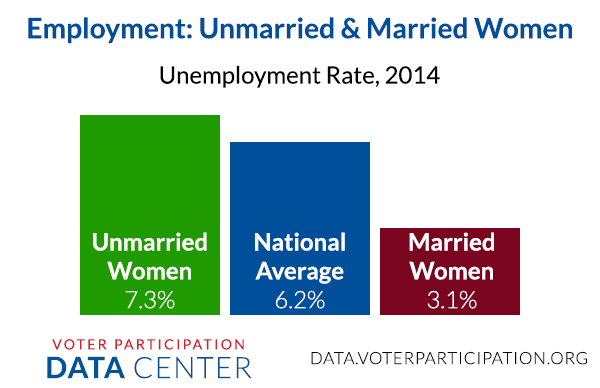
15.4 percent of unmarried women did not have health coverage in 2013—almost twice the rate for married women (8.3 percent).
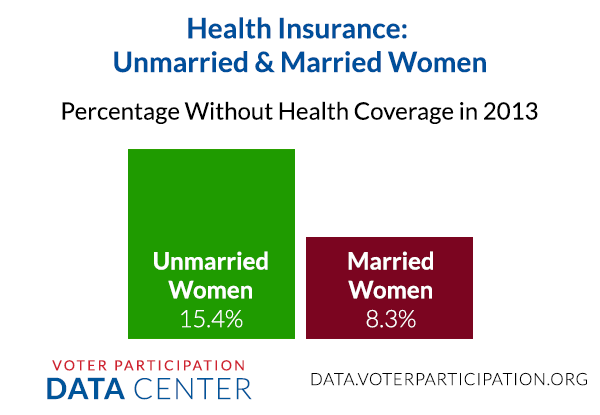
Unmarried women are disproportionately at the lower end of income brackets.
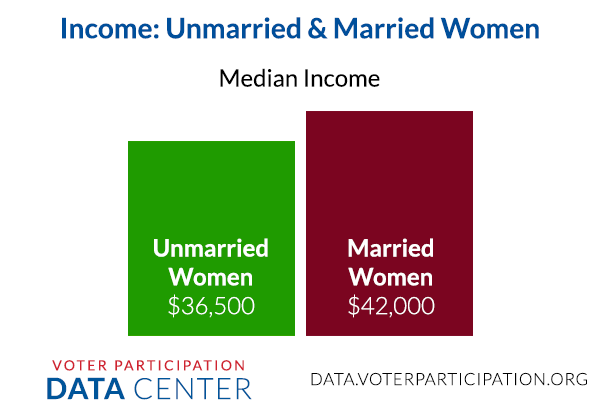
Women working full time make 80 cents for every dollar a man working full time makes. Unmarried women make substantially less. Latinas make the least of all unmarried women.
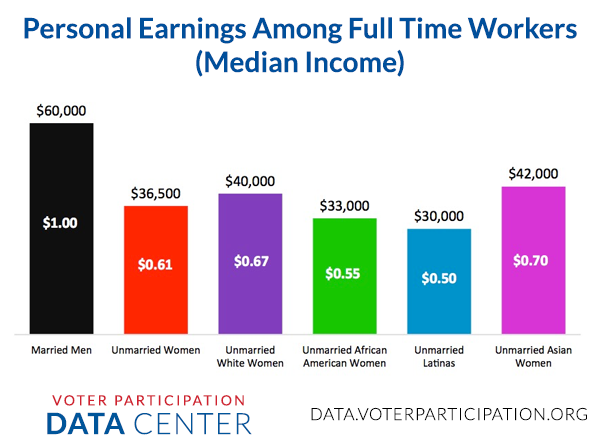
Unmarried mothers make significantly less than their married counterparts.

Unmarried women are almost four times as likely to live in poverty as married women.

Unmarried women are less likely to be homeowners.
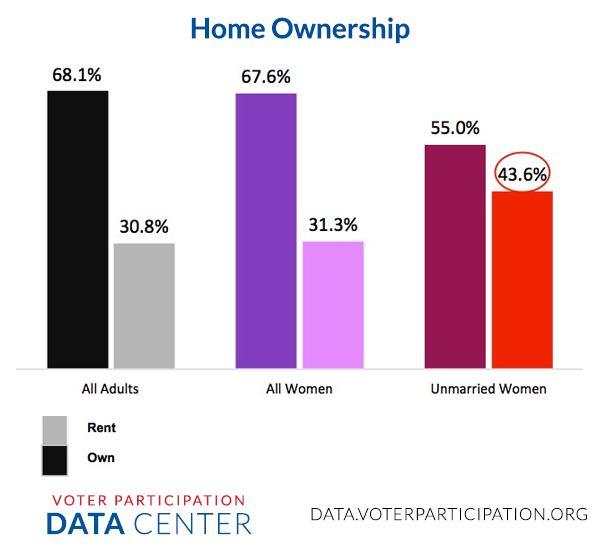
Over half of unmarried women do not have a employer-provided pension plan.
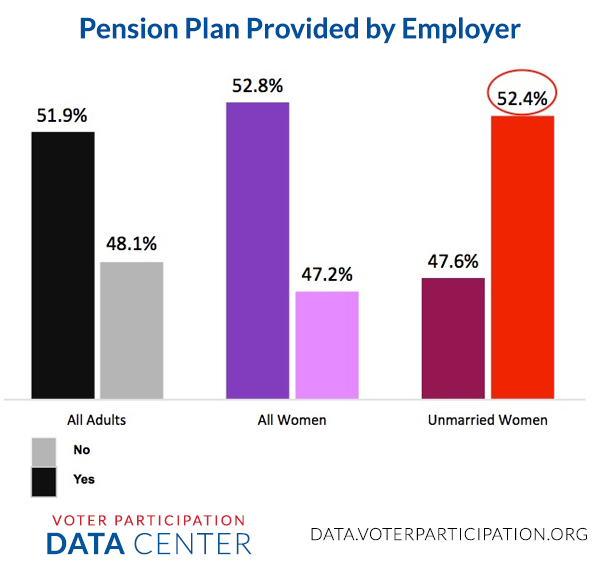
An in-depth demographic, economic and political look at unmarried women and the Rising American Electorate from Lake Research Partners.
- Unmarried Women: A Demographic and Economic Profile
- Unmarried Women: An Electoral Profile
- The Rising American Electorate: A Profile
- How the Rising American Electorate Register and Vote
- The Rising American Electorate: A Population` on the Move
New Poll: Unmarried Women Poised to Make the Difference in 2016
Unmarried women and other members of the Rising American Electorate could be responsible for Democratic presidential success in 2016, just as they were in 2012, according to a new national poll released today by the Women’s Voices Women Vote Action Fund. The survey, conducted by pollster Stan Greenberg and Democracy Corps, found that former Secretary of State Hillary Clinton leads likely Republican candidates in the 2016 presidential race by 62 percent to 33 percent among unmarried women voters. With all voters, Sec. Clinton begins with a 6 point lead over Gov. Mitt Romney and a 12 point lead over Gov. Jeb Bush.
The new national findings make clear that all candidates who aspire to the White House will need to speak to the financial insecurities many voters feel.
“Voters are still getting squeezed economically,” said Page Gardner, president and founder of the Voices Women Vote Action Fund. “But, our new research suggests that unmarried women could provide Democratic presidential candidates with a winning advantage if their concerns about their economic well-being are addressed.”
The survey was a joint project of Democracy Corps, WVWVAF, and the Voter Participation Center. The Voter Participation Center research related to nonpartisan questions regarding policy topics.
Downloads
Unmarried Women: Election-Night Poll Shows Overwhelming Support for Progressive Candidates in 2016
Unmarried women and other members of the Rising American Electorate (RAE) who plan to vote in 2016 will overwhelmingly support progressive candidates, despite the outcome of this week’s midterm elections. That’s one of many highlights of a new national survey conducted during the week of the election and released today by the Voter Participation Center and Democracy Corps.
The poll revealed that more than 40 percent of the Rising American Electorate (unmarried women, African Americans, Latinos and young voters) disapproved of the President. Their voting rates replicated the 2010 midterm elections and showed a significant drop-off from 2012 presidential-year levels. And yet, come the next presidential race, 2016 likely voters said they will support progressive candidates.
“Our polling shows that unmarried women, RAE members and other traditionally under-represented voters will increase their participation rates and turn out in force for candidates in 2016 who support an economic agenda that works for women and middle class,” said Page Gardner, President of the Voter Participation Center. “What we confirmed in the survey is that the 2014 midterm map was next-to-impossible for progressive candidates, and presidential-year voters turn out at the polls and react very differently than mid-term voters.”
This year, unmarried women represented 21% of all voters, just like in the 2010 midterms. Unmarried women favored Democratic candidates over Republicans by 60 percent to 38 percent, or a margin of 22 points, according to exit polls. In the previous midterms in 2010, by contrast, that margin was only +16. Nonetheless, the margins this year were not enough to counter the wave among other voters.
“The main message of the election and take-away from this election-night poll is surely a call to the Democrats’ national leaders to address this new economy where jobs do not pay enough to live on, working women and men are struggling without help, and good American jobs are not being created while the government is beholden to those with the most money,” said pollster Stan Greenberg of Democracy Corps.
When 2014 voters did get a chance to vote on economic policies that would aid working families, their support was clear. Voters in Alaska, Arkansas, Nebraska and South Dakota all voted to increase the minimum wage in their states. And in New Jersey, measures to guarantee paid sick leave for workers also passed on Election Night.
“The results on Tuesday were reaffirmed in our poll. Unmarried women and the RAE want to move ahead with an economic agenda that includes increases to the minimum wage, paycheck fairness, paid sick days and affordable child care and education,” Gardner said. “That’s a winning combination for 2016 candidates.”


